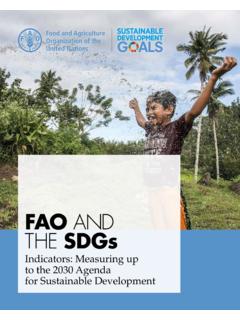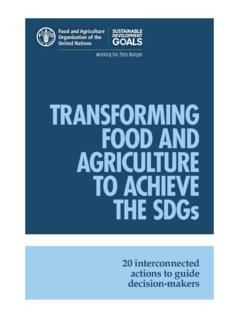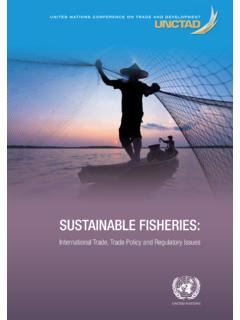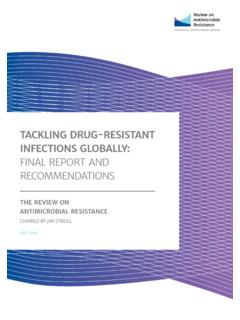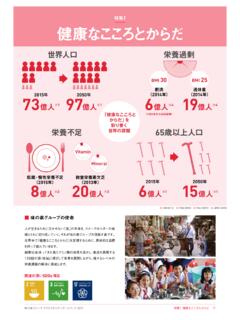Transcription of AMR Framework for Action Supported by the IACG …
1 AMR Framework for Action Supported by the IACG. Working Document | August, 2017. Analytic support was provided by McKinsey & Company Purpose of this document This document provides a short introduction to AMR, suggests a common language and outlines a proposed agenda for the global community and individual countries It was developed to support the IACG. The target audience are all leaders and practitioners from public or private sectors as well as civil society This is a working document that will continue to evolve over time Supported by the Interagency Coordination Group on Antimicrobial Resistance (IACG) 2. Executive summary 1 AMR is arguably the most complex threat to global public health, potentially leading to millions of deaths a year and hundreds of billions in annual economic damages by 20501. 2 The global fight on antimicrobial resistance has gained momentum with a multi-sectoral commitment to Action through a declaration on AMR at the 2016 UNGA. Effective work over the coming years is critical 3 A comprehensive mapping of current progress, gaps and key next steps is critical to maintain the political momentum initiated by the 2016 UNGA declaration on AMR and kick-start the work of the UN Inter-Agency Coordination Group ahead of their report back to the UNSG.
2 4 This documents describes a comprehensive approach to capture (1) all key content areas, (2). relevant levers to address them and (3) underlying enablers building on the UNGA declaration, the Global Action Plan and the SDGs 5 The Framework allows the identification of progress and gaps in key content areas. Some of the most challenging issues are Ensuring access to existing and new antimicrobials while promoting responsible use and stewardship Agreeing on priorities and mechanisms to foster innovation towards faster, cheaper diagnostics tests that cover all relevant pathogens, new medicines and vaccines Transforming animal husbandry and fisheries to substantially reduce antimicrobial use whilst boosting agricultural productivity and ensuring food security 6 Overarching needs include (1) increasing surveillance, (2) strengthening governance, (3). developing and implementing national Action plans and (4) securing required funding 1 , O'Neill et al. (2016): The Review on Antimicrobial Resistance; World Bank (2017) Drug-resistant infections a threat to our economic future Supported by the Interagency Coordination Group on Antimicrobial Resistance (IACG) 3.
3 2 The global fight on antimicrobial resistance has gained momentum through a multi-sectoral commitment to Action at UNGA in 2016. Select UN organisation efforts on antimicrobial resistance Global Action Plan (WHO, FAO, OIE) on AMR approved Improve awareness and understanding through effective communication, education and training UN General Assembly resolution on AMR: Strengthen the knowledge and evidence base through Codex Alimentarius surveillance and research WHO, FAO, OIE to FAO and WHO developed finalize a global Reduce the incidence of infection through effective development and harmonized food World Health Assembly sanitation, hygiene and infection prevention measures standards, guidelines and resolution Antimicrobial stewardship codes of practice to protect resistance: a threat to Optimize use of antimicrobials in human and animal health Framework the health of consumers global health security Develop the economic case for sustainable investment and SG to establish an and to ensure fair practices Rational use of medicines increase investment in new medicines, diagnostic tools, ad hoc interagency in food trade by prescribers and patients vaccines and other interventions coordination group 1956 1963 1998 2005 2011 2013 2015.
4 2016. Joint FAO/WHO Expert World Health World Health Day 2011 WHO convenes Sustainable OIE AMR. Committee on Food Assembly resolution WHO introduces 6-point first Strategic Development strategy Additives (JECFA) Calling for efforts to policy package to combat and Technical Goals (SDGs). FAO and WHO started address antimicrobial FAO Action AMR Advisory Group agreed on at UN. Plan meeting to evaluate the resistance, including on AMR (STAG- General safety of food additives through advanced AMR) Assembly World Bank and the presence of detection and education report on contaminants in food ( , AMR. toxicants and veterinary drugs). In addition, significant efforts have been undertaken by non-UN actors ( , publication of the O'Neill Review on AMR, G20 efforts, and many other initiatives). SOURCE: WHO, OIE, FAO, World Bank Supported by the Interagency Coordination Group on Antimicrobial Resistance (IACG) 4. 2 Effective work over the coming years is critical UN General Assembly resolution on AMR.
5 2017 2018-19 Over next 10+ years 2030. 2016. March 16: Report back to 73rd Implementation of Target date for Announcement of session of the UN national and global Sustainable Interagency General Assembly: priorities with sustained Development Coordination Group Interagency Coordination effort over time Goals chaired by WHO DG Group will produce report and UN Deputy SG for UN SG, who will report to Member States during May: National Action the 73rd session of the Plans due for UNGA. completion for WHA. SOURCE: WHO, OIE, FAO, World Bank Supported by the Interagency Coordination Group on Antimicrobial Resistance (IACG) 5. 3 Comprehensive mapping of current progress, gaps and key next steps is critical to maintain the political momentum initiated by the 2016 UNGA. declaration and support the work of the Interagency Coordination Group 150+ experts consulted 100+ articles and reports reviewed 30+ 10+ ~50 ~20. 10+ Academic experts Funders 20+ Scientific articles Global Action plans Private industry representatives 20+ 30+ Government representatives ~40 ~5.
6 Civil society Representatives High-level Databases representatives of multilateral reports agencies Supported by the Interagency Coordination Group on Antimicrobial Resistance (IACG) 6. 3 Input was sought from all IACG members IACG Member Organization Dr Hanan Balkhy Ministry of National Guard Health Affairs, Kingdom of Saudi Arabia Dr Jarbas Barbosa da Silva National Health Surveillance Agency (ANVISA), Brazil Prof. Otto Cars ReAct / Uppsala University, Sweden Prof. Junshi Chen China National Center for Food Safety Risk Assessment, China Prof. Dame Sally Davies Department of Health, United Kingdom of Great Britain and Northern Ireland Dr Lyalya Gabbasova Ministry of Health, Russian Federation Ms Martha Gyansa-Lutterod Ministry of Health, Ghana Individual experts Dr Jaana Husu-Kallio Ministry of Agriculture and Forestry, Finland Mr Martin Khor South Centre, Switzerland Dr Marco Marzano de Marinis World Farmers Organization, Italy Dr G rard Moulin National Agency for Veterinary Medicinal Products (ANMV), and Anses, France Dr Donald Prater Office of Foods and Veterinary Medicine, Food and Drug Administration, USA.
7 Dr Soumya Swaminathan Indian Council of Medical Research, India Dr Naoko Yamamoto Ministry of Health, Labour and Welfare, Japan Ms. Maria Helena Semedo Food and Agriculture Organization of the United Nations (FAO). Dr Hajime Inoue World Health Organization (WHO). Dr Matthew Stone World Organization for Animal Health (OIE). Dr Marijke Wijnroks Global Fund to fight AIDS, Malaria and Tuberculosis (GFATM). Dr Mark Pearson Organization for Economic Cooperation and Development (OECD) In addition, WHO, FAO. Interagency Dr Luiz Loures Joint United Nations Programme on HIV/AIDS (UNAIDS) and OIE. representatives Mr Elliott Harris United Nations Environment Programme (UNEP) members of the IACG. Dr Stefan Peterson United Nations Children's Fund (UNICEF) secretariat Dr Enis Baris World Bank provided substantial Ms Ana Hinojosa World Customs Organization (WCO) input Mr Minelik Alemu Getahun World Intellectual Property Organization (WIPO). Ms Christiane Wolff World Trade Organization (WTO). Supported by the Interagency Coordination Group on Antimicrobial Resistance (IACG) 7.
8 4 The approach builds on the UNGA political declaration, the Global Action Plan and the Sustainable Development Goals UNGA political Global Action Sustainable Development declaration Plan Goals Provides the mandate of the Looks at AMR through one- Provides the long-term IACG health approach considering development priorities of the human health, animal health, UN member states Proposes to tackle AMR by agriculture and environmental reducing infections and aspects AMR puts achievement of unintentional exposure, several SDGs directly or optimizing use and Defines five strategic priori- indirectly at risk sustained innovation using ties (awareness, surveillance various levers and research, reducing inci- At the same time, the actions and objectives related to dence of infections, optimizing Highlights importance of use, increasing investments). many SDGs are closely affordability and access related to key AMR content Suggests increased attention This document aims to areas support and accelerate the to antibacterials implementation of the GAP.
9 Supported by the Interagency Coordination Group on Antimicrobial Resistance (IACG) 8. 4 The approach reflects the key priorities and focus of the UNGA political declaration Tackling AMR through reducing infections and unintentional exposure, optimizing use and sustained innovation Affordability and access to existing and new medicines, vaccines and diagnostics as well as to broader health services and food, clean water and environment Delinkage of the cost of investments in antimicrobial R&D from price and volume of sales, to foster both stewardship and development of medicines Use of diverse set of levers including surveillance and monitoring, awareness and capacity building, policy and regulation, funding and piloting Broad focus on bacterial, viral, parasitic and fungal microorganism, yet increased attention on resistance to antibacterials SOURCE: UN General Assembly Resolution 71/3 Supported by the Interagency Coordination Group on Antimicrobial Resistance (IACG) 9. 4 The approach is aligned with the Global Action Plan on AMR, builds on it, and supports its implementation across key priorities This assessment maps the relevant content and key gaps against key AMR priorities in the Global Action Plan In line with Global Action Plan, this approach looks at AMR through one-health approach considering human health, animal health, agriculture and environmental aspects The proposed Framework builds on the Global Action Plan and includes updated information since its publication in 2015.
10 The ultimate purpose of this effort is to support and accelerate the implementation of the Global Action Plan and related priorities Supported by the Interagency Coordination Group on Antimicrobial Resistance (IACG) 10. 4 Tackling AMR is crucial to achieve the Sustainable Development Goals (SDGs) Agenda for 2030. AMR requires unprecedented levels of global coordination AMR puts the achievement of SDGs related to health, agriculture, animals, the environment and food directly at risk. In addition, actions and objectives related to these SDGs are closely related to individual AMR content areas In addition, AMR puts the achievement of some SDGs indirectly at risk, due to cascading impacts on economic wellbeing and inequality Further SDGs minimize the negative impact of AMR and have implications for the implementation of global and national Action plans Supported by the Interagency Coordination Group on Antimicrobial Resistance (IACG) 11. 4 While primary focus is on bacteria and antibacterials, viral, parasitic and fungal microorganisms are also considered Primary focus, in line with Broader focus, in line with Global Action Plan on AMR Global Action Plan on AMR.










